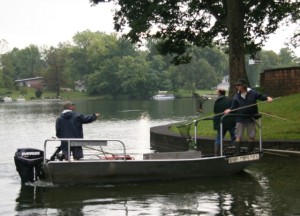
Fred Cronin IDNR Fisheries Biologist (back) directs lake residents Doug Carney from IDNR and Dr. Chris Theodorkis from SIUE as they collect fish to be counted, measured and released back into Dunlap Lake Thursday, Sept. 7. A few fish of varying types and sizes were kept for the SIUE Environmental Science Department to test for toxins thanks to a grant from the Urban Institute.September 9, 2016
Dear Ms. Green,
The purpose of this letter is to summarize the results of the electrofishing survey conducted on Dunlap Lake on September 8, 2016. I will also compare this data to the 4 previous surveys (1998, 2001, 2004, and 2009) and provide some management recommendations. We shocked for 30 minutes and got a good sample of fish. We collected the following species:
Species Number
Largemouth bass 49
Bluegill 44
Walleye 15
Gizzard shad 80
Green sunfish 12
Channel catfish 4
Redear sunfish 3
Common carp 1
Yellow bullhead 1
Largemouth bass – The tables below show the largemouth bass numbers and size distribution from this survey compared to the previous surveys. The bass numbers are better than ever and appear quite stable over the years. The size distribution looks very good with good numbers in every size class. The 29% under 8 inches suggests very good natural reproduction of bass this year. In summary, this survey shows a very healthy, stable bass population.
LMB Catch per 30 minutes of shocking effort:
1998 43
2001 31
2004 35
2009 40
2016 49
| LMB Size Distribution: | |||||
| 1998 | 2001 | 2004 | 2009 | 2016 | |
| % less than 8.0 inches | 19 | 0 | 6 | 3 | 29 |
| % between 8.1 and 12 inches | 57 | 26 | 49 | 60 | 20 |
| % between 12.1 and 15 inches | 24 | 26 | 17 | 18 | 31 |
| % over 15.1 inches | 0 | 48 | 29 | 20 | 20 |
Bluegill – The bluegill collected ranged from 3 to 8 inches. This is pretty good for a lake with gizzard shad and green sunfish present.
Redear sunfish – 3 redear sunfish were collected. They were quality sized fish 8-9 inches.
Walleye – 15 walleye were collected. They ranged from 10-20 inches and were in great condition. The numbers, quality, and condition of these fish is very impressive. The recent stocking of these fish is working very well. It appears a very healthy, fishable population is becoming established.
Crappie – No crappie were collected. The crappie move to deeper water at this time of year and are difficult to collect by shocking, so this survey may not be representative of the crappie population. However, the fact that we did not see small crappie suggests that the population is not over-crowded and growth and average size of crappie should be good.
Channel catfish – Four fish collected. They ranged from 22 to 28 inches and were in great condition.
Summary and Recommendations – This survey shows a very healthy and well balanced fish community. Bass fishing should be very good. Walleye fishing should be very good. Crappie and bluegill fishing should be good. Catfish fishing should also be good. The lake does not need any corrective stocking or management. With the abundant gizzard shad population continued stocking of supplemental predator species (walleye, hybrid striped bass, and muskie) should continue as desired. The walleye stocking in particular seems to be working very well. Walleye and hybrid striped bass can be stocked at 10-25 per acre, muskie at 1-2 per acre. You can always add more channel catfish, 6-8 inch at a rate of up to 50 per acre. If you need more information or have any questions please contact me.
Sincerely,
Fred A. Cronin
Dist. 16 Fisheries Biologist
Horseshoe Lake State Park
3321 Hwy 111
Granite City, IL 62040 (618) 931-4217
